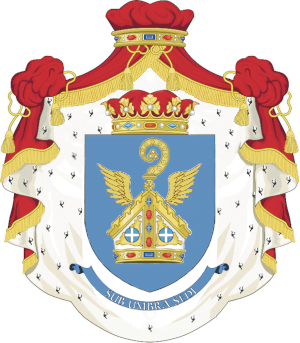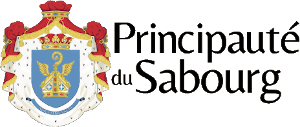The fiefdom of Castrum Sepulchri is mentioned in a document from 954, which concerns the donation of the aforementioned territory by Count Guidone of Ventimiglia to the Cistercian Fathers of the island of Lerino, of a territory of approximately 14 km2 bordering San Remo to the north ( Republic of Genoa) and with Perinaldo to the south (Kingdom of Savoy), with Ospedaletti to the east and with Vallebona to the west (Republic of Genoa), in addition to the Chaplaincy of San Michele in Ventimiglia (today the church of San Michele of the Diocese Ventimiglia-Sanremo) .
This document, considered apocryphal, probably as the original had been lost, was drawn up again in 1304 by Father Sicard (seborga municipal administration source dating back to 1963) with the information in his possession and contained in the original document; but this remake was considered authentic until 1757, the year in which Turin archivists (not surprisingly...) made its falsity clear.
The only document never disputed and considered original from 1177 , which has survived to this day, concerning a controversy between the monks of Lerino and the counts of Ventimiglia regarding the boundaries of the corresponding properties between Vallebona and Seborga, confirms the existence of the Ancient Abbey Principality of Seborga.
The territory of Sabourg, following the deed of donation in 954 AD, continued to depend administratively on the Abbey of Lérins, located in the county of Provence which, after having belonged to the Angevins of Naples, was annexed to the Kingdom of France in 1481.
In 1261, the Prior of the church of San Michele in Ventimiglia, Giacomo Costa, drew up, by delegation from the Abbot of Lerino, the Statutes and Regulations of the Principality.
The Provençal monks made little profit from the income of the estate and were often forced to take out cash loans to alleviate the miserable life of their subjects.
The Prince-Abbot Monsignor Cesare Barcillon, in December 1666, in order to obtain substantial income, opened a monetary workshop on the floor below the Abbey Palace, located in Piazza San Martino in Seborga: the first mint keeper was Bernardo Bareste of Mougins. Several coins were struck and the activity lasted until October 1689. The Luigini, however, contained a low rate of silver and therefore were not appreciated even in the East, also due to the competition from other mints, such as that of the county of Tassarolo.
After five years of minting, King Louis XIV of France ordered its closure.
Regarding the princely rank and the right to mint, these were prerogatives belonging to the Holy Roman Emperor and the Pope who could extend them to any of their vicars. In the case of Seborga, it is assumed that the source was not imperial, because, in addition to there being no document to prove it, the assets of the county of Provence, which became extinct, passed to the Kingdom of France, absolutely independent of the Empire.
Its origin, therefore, had to be exclusively papal: every Abbot could attribute (and attribute to himself), with Pontifical Authorization, noble titles. And the Abbots of Lerins did this, naming themselves "Princes" and assigning their aristocratic predicate to the territory of Sabourg, as deputies of the Holy See's authority over the Monastery. As Prince-Abbot, he did not depend on the secular clergy but only on the Pope ("nullius diocesis"): in fact, he directed the parishes of the territory and appointed the provost of Seborga.
The Prince-Abbot did not frequently stay in Seborga and this absence was negative for the inhabitants of the villages within the territories of the Principality of Sabourg. He appointed a Vicar, called the Podestà, whose role lasted from six months to three years and could be re-elected. Assisted by two Mayors and two Consuls, he administered the fiefdom, under the careful supervision of the absent Abbot, to whom he had to present continuous reports of his public activity.
The Prince-Abbot, every now and then, paid a visit and stayed in the abbey palace: he was entitled to the treatment of "His Most Reverend Lordship", his position was ad vitam, as foreseen by the regulations of the Cistercian Order, for which each Abbot is elected Lifetime.
The monks, however, tired of this delegated administration which yielded little due to the debts contracted, first with the Genoese in 1584, with a contract drawn up by the Notary Nicolo' Vigano, then with other monasteries and a French nobleman, decided to sell the Principality. The first sale was planned to the Republic of Genoa following the debt contracted previously, then to the Duke of Savoy Vittorio Amedeo in 1697, both canceled by the Supreme Pontiff and finally the sale took place on 30 January 1729 in favor of the King of Sardinia , Vittorio Amedeo II of Savoy who aspired to get ever closer to the longed-for sea.
The Savoys, not wanting to give up the long-awaited strategic territory, convinced the Abbot of Lérins to reunite the congregation of the fathers of Lérins on 11 December 1728 and confirm the long-awaited alienation to the King of the house of Savoy and then carry out the sale to Paris on 30 January 1729.
In an exchange of communications dated 12 January 1729, between the Lawyer Lea and the Archbishop Prince of Embrun, Monsignor Pierre Guerin de Tencin, Apostolic Commissioner and delegate of the Pope for the approval of the sale, who among other things cites the already attempted sale of 1697, a letter from Pope Benedict XIII dated 13 October 1728 (Nostra Apostolica Petitum) was mentioned which authorized the sale on condition that the debts weighing on the Principality were paid. This letter reads verbatim (source: State Archives of Turin): «…in exstravaganti ambitious contrabona Eccelsia alienantes statutis…»
The Archbishop and Prince of the metropolitan city of Embrun, Pierre Guerin de Tencin was delegated by the Supreme Pontiff Benedict XIII to settle the controversy between the Republic of Genoa which could count on the friendship of the Podestà of Sabourg, Monsignor Giuseppe Biancheri and the Abbot of Lerin, pushed by the Savoys to sell the Principality of Sabourg.
The Apostolic Commissioner carried out a detailed investigation, which began in Paris and concluded in Versailles on 8 July 1728. This document included 9 points to be respected. It is considered essential to underline that for the definitive alienation the authorization of the Fathers of the Montmajour Abbey of Arles was required, since in the original donation document of Count Guidone, dating back to 954, in the event of attempted alienation by the Cistercian Fathers and Monks of the Island of Lerino, of the aforementioned territory of Seborga, including the Chaplaincy of San Michele in Ventimiglia, the legacy would have been automatically transferred to the Fathers of Mont Majeur d'Arles.
Therefore the delegate of the Supreme Pontiff, Archbishop and Prince of Embrun, consulted the aforementioned Pards of Arles who quantified the amount of compensation in 15,000 lire of Savoy currency.
The sale amount, we remember set at 147,000 Lire of Savoy currency, had to be deducted by the sum equal to 15,000 Lire of Savoy currency, set for the compensation of the Fathers of Montmajour of Arles. The remaining sum of 132,000 Lire of Savoy currency, according to the document viewable in the Turin Archives, drawn up by the delegate, Archbishop and Prince of the metropolitan city of Embrun, should have been paid to the Republic of Genoa to pay off the debts contracted way back 1584, with relative receipt to be attached to the deed of sale.
In any case, the Archbishop and Prince of the metropolitan city of Embrun, delegated by the Supreme Pontiff Benedict XIII, authorized the sale conditioned therein in the absence of further papal authorization.
The sale contract was stipulated by the lawyer Francesco Lea, in the presence of a representative of the last mitred Prince Abbot Fauste de Balon, the Reverend bursar of the Abbey of Lerin, Father Benoit de Benoit. The sum was set at 147,000 lire of Savoy currency. The sale was carried out in Paris in the presence of a notary who registered the effects.
A copy of the aforementioned deed of sale to the Savoys is kept in the State Archives of Turin (I).


